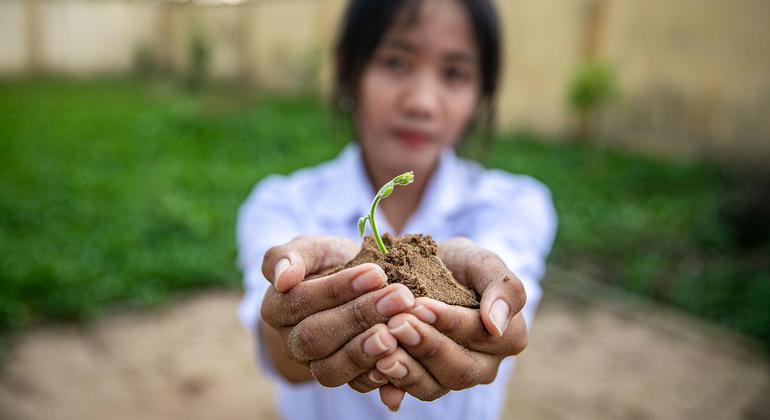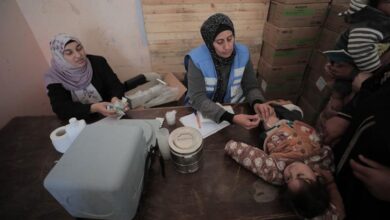Climate crisis: 5 things to watch out for in 2025

1 Can we keep 1.5 alive?
“Keep 1.5 alive” has been the United Nations’ rallying cry for years, referring to the goal of ensuring average global temperatures do not rise more than 1.5 degrees above pre-industrial levels. The scientific consensus is that lack of action will have dire consequences, especially for so-called “frontline states,” such as island developing states that could disappear under ocean as sea levels rise.

A man sits fishing on sandbags to protect the Pacific island nation of Tuvalu from sea erosion.
At COP30, the United Nations climate conference scheduled to take place from 10 to 21 November 2025, mitigation (in other words, actions and policies designed to reduce emissions) greenhouse gas emissions that contribute to rising temperatures) will likely be the main focus.
Countries around the world will come forward with upgraded and more ambitious commitments to reduce greenhouse gas emissions. This is both an acknowledgment that current commitments are grossly inadequate in reducing temperatures, and is part of the agreement that Member States signed in 2015 in COP Paris (countries are expected to “step up” their commitments every five years. The last time this happened was at COP Glasgow 2021, delayed by a year because COVID-19 pandemic).
2 Protect nature
Holding COP30 in the Brazilian Amazon rainforest region has symbolic importance. It recalls the early days of international efforts to protect the environment: the key “Earth Summit”, which led to the establishment of three environmental treaties on climate change, biodiversity and desertification, which took place in the Brazilian city of Rio de Janeiro in 1992.

A parrot standing on a tree branch in Maharashtra, India.
This position also highlights the role of nature in the climate crisis. The rainforest is a giant “carbon sink,” a system that captures and stores CO2, a greenhouse gas, while preventing it from entering the atmosphere, where it contributes to warming.
Unfortunately, tropical forests and other “nature-based solutions” face threats from human development, such as illegal logging that has devastated large areas of land. in the area. The United Nations will continue efforts begun in 2024 to improve the protection of tropical forests and other ecosystems, at biodiversity discussion will resume in Rome in February.
3 Who will pay for all this?
Financing has long been a thorny issue in international climate negotiations. Developing countries argue that rich nations should contribute more to projects and initiatives that help them transition away from fossil fuels and power their economies with renewable sources. clean energy. The obstacle from rich countries is that fast-growing economies like China, currently the world’s largest emitter of greenhouse gases, must also bear their share.

Activists protest against fossil fuels at COP29 in Baku, Azerbaijan.
At COP29 in Baku, Azerbaijan, one Breakthroughs of sorts has been implemented, with the adoption of an agreement to triple the amount of climate finance paid to developing countries, to $300 billion per year by 2035. This agreement is a clear step forward , but the final total is still much lower than the $1.3 trillion that climate experts say these countries need to adapt to the crisis.
More financial progress is expected in 2025, at peak in Spain at the end of June. The Financing for Development Conference only takes place every 10 years, and next year’s conference is seen as an opportunity to make fundamental changes to the international financial architecture. Environmental and climate concerns will be raised and potential solutions such as green taxes, carbon pricing and subsidies will all be on the table.
4 Law making
When the attention of International Court of Justice transition to climate change in December, it was hailed as a landmark moment regarding states’ legal obligations under international law.

Vanuatu regularly experiences devastating extreme weather, such as storms, which is being exacerbated by climate change.
Vanuatu, a special Pacific island nation vulnerable to the crisis, asked the court to take an advisory role to clarify states’ obligations regarding climate change and inform any future judicial proceedings.
Over a two-week period, 96 countries and 11 regional organizations participated public hearings before the Court, which includes Vanuatu and a group of other Pacific island countries, as well as major economies including China and the United States.
the ICJ will consider for several months before rendering an advisory opinion on the subject. Although the opinion will not be binding, it is expected to guide future international climate law.
5 Plastic pollution
UN-convened talks on tackling the global plastic pollution epidemic move closer to a deal during the negotiations in BusanKorea.
Some important progress was made in the November 2024 negotiations – the fifth round of negotiations following the 2022 UN Environment Council resolution calling for an international legally binding instrument on plastic pollution, including marine pollution.
Agreement needs to be reached on three key areas: plastic products, including chemicals; sustainable production and consumption; and finance.

Plastic bottles are collected for recycling in India.
Member states now have the responsibility to find a political solution to their differences before the next session begins and reach a final agreement that addresses the entire lifecycle of plastics and creates global momentum. There is a growing demand to end plastic pollution.
“It is clear that the world still wants and demands an end to plastic pollution,” speak United Nations Environment Program (UNEP) CEO Inger Andersen. “We need to make sure we create a tool that addresses the problem robustly rather than hitting its potential weight. I call on all member states to join in.”




